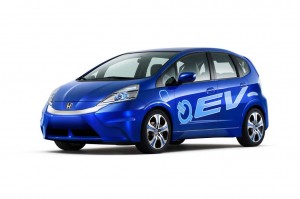
The Honda Fit is likely to be among the first products to roll out of the maker's new Mexican plant. An EV version of the subcompact will launch in 2012.
Plagued by the threat of earthquakes, tsunamis — and lopsided exchange rates, Japanese automakers are shifting more and more manufacturing off the home islands – Honda announcing it will build its eighth North American assembly plant in Mexico.
Set to begin production in 2014, the $800 million factory will produce subcompacts – such as the Honda Fit and CR-Z — for sale in the U.S., Canadian and Mexican markets, the automaker says. Assembling those low-priced models has become increasingly difficult in Japan, especially with the yen rising to its highest level ever, all but ensuring imports would be money-losers in the North American market.
The factory will employ 3,200 and have an annual capacity of 200,000. That will bring the to 1.83 million the total number of Honda and Acura cars and light trucks the carmaker will be able to produce in North America – which it estimates will be about 87% of its volume once the new assembly plant opens.`
“With growing demand for fuel-efficient vehicles, this plant will increase Honda’s ability to meet customer needs for subcompact vehicles from within North America,” said Tetsuo Iwamura, president of American Honda Motor Co., who adds that it will allow the maker “to more flexibly respond to changing market conditions.”
Market conditions are clearly changing. Since fuel prices began their run-up in 2008, the small car market has shown steady growth and industry analysts expect it to push well north of 20% of overall U.S. sales. The Big Three Japanese makers, Honda, Nissan and Toyota, have traditionally dominated the segment, especially in the subcompact niche where they effectively played alone until recently.
But Honda – like its Japanese rivals – has watched the small car segment burst with new competition from the likes of the Ford Fiesta, Chevrolet Sonic, Hyundai Accent and other increasingly attractive alternatives.
At the same time, the yen has continued gaining strength, and is currently at just under 77 to the dollar – down from a recent peak of 85 in April, and 110 three years ago. Every yen shift adds up to hundreds of dollars in added costs per vehicle, according to research by Deutsche Bank. Barring a sudden surge in the dollar, it is expected to become increasingly difficult to maintain production in Japan for the North American market.
That is compounded by concerns raised in the wake of the devastating earthquake and tsunami that struck Japan in March. Honda’s research and development center in Tochigi was heavily damaged, an employee killed by falling debris. Like its local competitors, Honda’s Japanese production base was largely idled for a month due to damage and parts shortages.
Its North American operations were also impacted – the new 2012 Honda Civic still running below original projections – and that is likely to result in Honda expanding its North American supply base, as well, even as it readies the new Mexican assembly plant, industry sources anticipate.
The new factory will be based in the state of Guanajuato, north of Mexico City, an area where a number of auto plants and suppliers already operate – and about 200 miles from an existing Honda car and motorcycle plant in Jalisco.
The additional plant may reduce exchange rate pressures but it does plant Honda firmly in the midst of the Mexican drug wars, a crisis that has so far cost more than 50,000 lives. While the many automakers operating in the country insist they have been largely unaffected by the crisis, many foreign manufacturers have sharply reduced the number of foreign workers they now base in Mexico hoping to avoid the kidnappings and ransoms that have become endemic in the country.
